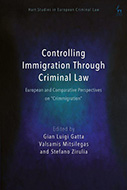Controlling Immigration Through Criminal Law: European And Comparative Perspectives On ‘Crimmigration’

Editors: Gian Luigi Gatta, Valsamis Mitsilegas, & Stefano Zirulia
Publisher: Hart Publishing, 2020. 304 pages.
Reviewer: Lisa Marie Borrelli ǀ January 2022
Migration as a topic has been central to the political controversies of many nation states and other political bodies over the past decades. One part of the debates covers issues related to security, bringing up state competencies regarding the management of borders and the enforcement of deportation procedures, but that also relates back to the nature of state sovereignty to steer migration in general. In order to increase control, resulting migration policies often involve and link back to other policy fields and laws such as criminal law or social policies, that become relevant fields contributing to practices of migration enforcement and the adjustment of migration law, and that affect the handling of migration in practice.
Given the restrictive and right-wing populist movements that attempt to curb migration flows over the past years, much discussion focuses on the so-called ‘illegal entry’ and/or staying of migrant individuals, or the facilitation and support of such entry, and how it can be governed. This has led to the ‘crimmigration approach’, a term coined by Juliette Stumpf in 2006 that describes a fusion of legal fields. Indeed, research has shown how criminal and (im)migration become increasingly intertwined, and how the role of criminal law grows for questions in the field of migration.
Based on an international conference that took place in Milan (at the Università degli Studi, Department of Law Cesare Beccaria) in 2018, this book edited by Gian Luigi Gatta, Valsamis Mitsilegas and Stefano Zirulia sets out to deliver a ‘critical analysis of the legislation, case-law and practices of a number of transit and destination states where the intersection between criminal and migration law is concerned’ and to ’cast light on the lack of consistency, effectiveness and fundamental rights deficit that these systems display’ (p.2).
The introduction and twelve chapters take up crimmigration as a theme and provide a systematic and comprehensive overview of how criminal law grows in its relevance for migration management. The editors and various authors offer a European, domestic, and comparative law perspective and critically engage with trends that criminalize “irregularized” migrants and asylum seekers. Moreover, they take up the criminalization of ‘human smuggling’ on the European and nation state level and discuss the intersection with fundamental human rights that both, accused smugglers and migrants, should be guaranteed.
The book is divided into three sub-sections — which focus on the framing of the crimmigration debate, the national, European, and comparative perspectives of the criminalization of migration, and ending with a specific focus on smuggling, humanitarian assistance and human rights violation in the European Area – each of which is dense in their political and legal analysis. Given that this book is the outcome of a conference, the chapters speak closely to each other, also creating some overlap, which is, however, helpful. Since the reader will find more conceptual chapters in the beginning, which study broader European frameworks and discourses, the following comparative studies give concrete examples of how, e.g., human trafficking charges play out in different country contexts. The authors further criticize the framing of mobility as a mere security discourse – and thus simply as a threat to border integrity – as opposed to their understanding of migration as intrinsic to human nature. While they are aware of prior works on crimmigration, the editors highlight that fast-changing regulatory frameworks make this work necessary, which can be agreed upon. The book takes into account recent legal reforms (2018-2020), case-law and practices related to deportation, detention and criminalization of undocumented individuals — including chapters that discuss removal from EU territory, discretion and politics, as well as media influences on implementation practices. The chapters further discuss the limitations of legal grounds to stay (for regular entry and hence increasing precariousness of migrant individuals), the Return Directive, and the so-called Facilitators package and criminalization of humanitarian support for undocumented migrants.
The introduction sets out to broadly criticize the lack of creating legal routes of protection and assesses that it is not only the nation states that criminalize undocumented migration and its assistance, but also the supranational frameworks. The editors conclude that the protection of fundamental rights can only be reached once ‘legality and solidarity are no longer perceived as conflicting values’ (p.6). Elspeth Guild supports this in her analysis of the Palermo Protocols and the Global for Compact Migration, showing that both policy frameworks actually increase unsafe and irregular migration. Indeed, this chapter introduces the reader to several issues that are covered more deeply later in the book, including the outsourcing of border control and the ignorance of human rights by supranational and national polices.
Valsamis Mitsilegas offers a perspective on the Palermo Protocols as well as on the Facilitators package via brief overviews of recent court cases in various countries that show a rather conscious choice of criminalization. This also holds true for the criminalization of entry, transit, and re-entry of migrant individuals.
In the third chapter, Gian Luigi Gatta identifies three overlapping criminal policy strategies that are used in the field of migration and thus ‘outside the scope of the criminal justice system to maximise their efficiency’ (71). The introduction of criminal law has consequences for immigration law violations, while an introduction of (administrative) immigration law has consequences for criminal convictions. Finally, the introduction of criminal justice tools, e.g., custodial measures and related procedures, has consequences for immigration law violations. This blending of criminal and administrative or immigration law supports a parallel legal system, says Gatta, that targets migrants, leaving out guarantees which would limit the scope of application if these strategies would be used in purely criminal justice procedures.
The first part of the book might have better given a more historic, detailed perspective. Instead, readers are introduced to bits and pieces of legislative developments over time, but receive less of a coherent historical summary. The authors do, however, cover a broad ground of European policies and developments that are also contextualized with other perspectives, such as Canadian jurisprudence or U.S.-related criminalization of unlawful immigration.
The second part of the book focuses on a comparative approach by presenting selected case studies that discuss various crimmigration regimes. The Spanish deportation regime offers an insightful possibility to show how ‘crimmigration policies enable the consolidation of racially and ethnically biased models of migration enforcement’ (Brandariz, Chapter 6, p.138). Maartje van der Woude enriches this perspective with a case study on the Netherlands and how so-called street-level bureaucrats conduct border controls based on ethnicity and race. The data are included in an interesting discussion of direct and indirect discrimination based on Art. 21 EU Charter and Art. 18 EU Treaty, concluding that the emergency and crisis driven debates allow for blurred normative, functional, and discursive barriers between crime and immigration control that finally also effect on-the-ground implementation. This crisis framing is taken up by Nikolaos Chatzinikolaou in his presentation of the Greek case, in which emergency legislation not only remained in force for thirty years, but where an increase in anti-migrant resentments caused a toughening of criminal sanctions directed towards migrant individuals and those identified as smugglers. The detailed overview of sanctions and penalties allows for a deepened understanding of criminalization practices in law and in the courts. A similar case of legal precarity can be found in Italy (Cancellaro), where unlawful immigration detention happens ‘despite specific national and European legislation’ (p. 193). The pertinent chapter offers an analysis of how the Italian legal framework was influenced by various judgements of the ECHR and local courts, especially the Khlaifia judgment that established ‘hotspots’ and should have (but failed to) reduce arbitrariness. Given that multiple authors argue that detention is used arbitrarily, e.g., to establish responsibility (see detention of those rescued on ships who were not allowed to disembark in the Italian case), Justine N. Stefanelli closes the second section with an analysis of EU endeavors to develop a clear set of detention standards. Looking at the Reception Conditions Directive and later on the Dublin III Regulation, as well as the Return Directive, Stefanelli concludes that there have been multiple attempts by, e.g., the CJEU to define reasons for detention and deadlines or to underline the detainees right to be informed. Yet, despite several judgements supporting the need for ‘humane treatment’, there are also decisions that enable broader detention practices and thus fail to secure the fundamental rights of detainees.
The last two chapters take again a broader, or more theoretical perspective. Stefano Zirulia studies the over-criminalizing conduct of anti-smuggling measures on a European level, and takes up the most recent investigations, as well as convictions of those helping migrants (at sea and on land). He He concludes that the reforms and existing legislation on a national and European level weaken solidarity, leaving smuggling in the hands of a dangerous market mostly interested in economic gain. This chapter highlights the fact that the fear of pull factors, if the Facilitators package would be changed, is empirically groundless, and that the Charter of Fundamental Rights makes penalization of humanitarian conduct difficult. The last chapter, written by Luca Masera, provides a thought-experiment regarding the liability of European governments for migrants’ hardship and discusses how criminal law could be used also as a tool to defend those excluded. Based on Italy as a case example, the chapter discusses to what extent the Italian government could be charged for being associated with the crimes happening in Libya and its detention camps, including torture and rape. Masera argues that the government’s contribution to the dire circumstances in Libyan detention camps could indeed lead to a conviction, despite the fact that Italian criminal law lacks a provision for ‘crimes against humanity’. This chapter raises the thought-provoking question of whether it would be possible to generally charge governments and authorities with misconduct.
Given the tightly connected chapters elaborating in detail on various criminalizing processes, they unavoidably generate some repetition. This is, however, not a disadvantage of the book, since first, edited volumes do not need to be read chapter by chapter. Instead, they give the option for readers to pick out relevant themes. Second, the overlapping chapters speak to each other and allow readers to study an issue from different angles, albeit through the EU perspective or that of a specific Member State (and how they handle policies on the ground). Finally, the repetition is unavoidable given that each chapter elaborates on the intricacies of criminal law and migration law within a European framework. The chapters are carefully selected and take up the topic in a very detailed manner. They are well connected and well-tuned, without being overly repetitive. Instead, the reader gains an insightful understanding of international, European, and national legislation at the intersection of criminal and migration law.
References
Stumpf, Juliet P. 2006. ‘The Crimmigration Crisis: Immigrants, Crime, and Sovereign Power’. American University Law Review 56 (2). http://digitalcommons.wcl.american.edu/aulr/vol56/iss2/3.
Lisa Marie Borrelli, Dr. rer. soc., Postdoctoral Researcher, HES-SO Institute of Social work and nccr – on the move.


